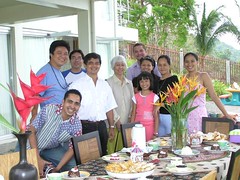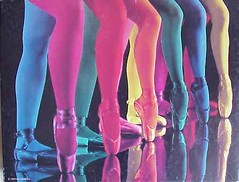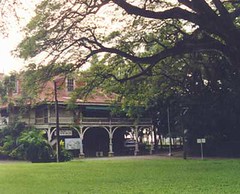 (photo by: Carmen del Prado)
(photo by: Carmen del Prado)Among the lessons learned on this school break is the very subtle power of the tea. With its simplicity and smoothness, it bridges everyone to a celebration of a wonderful life. Such was this tea party in the slopes of Mampas in Valencia.
The connection towards the gathering started with the tiny blue card inviting me for an afternoon tea to formally welcome a couple, both visual artists. With just the card with a bouquet of wild flowers, promising an afternoon of warmth and elegance. That special touch was an achievement that only a hostess like Ms. Arlene Delloso-Uypitching can pull without much effort. Simply so lovely and true to the tea spirit.
It was a small gathering at Don and Arlene’s abode in the sky. The four-wheel drive towards this spot in Mampas on a summer day was thrilling with twist and sharp curve under the able control of Mampas king, Don. The folk genres were rolling with the greens and blooms of nature.
The welcoming smiles of ‘Prince’ David and ‘Princess’ Hannah confirm the promise of pure joy that afternoon. The small party was meant to be a ‘fellowship of the fortunate few.’ All of us there were actually ‘Mampas regulars.’ Although the sweet memories of our Mampas ride up was not to be the only common ground.
Working with Arlene in the preparation were the tea party honorees themselves, Cez Nuñez and Brian Uhing (Brühn in the Philippine art world), who have just decided to make Valencia their home in Negros.
While waiting, I kept myself busy by exploring once again the beauty of the house. Something on the wall is new- a nude by Cez. Her strokes run with passion: a beautiful woman showing her back. Then a new framed glory on a table, a photograph of Brian’s masterpiece. This oil called Lulu has Swahili pearls on the pear in royal bedroom glory. You could see the amazing control of the brushstrokes – smooth yet powerful. His was classical in discipline, but less of the silence as there was so much sense of humor.
He showed me another photograph of his work. It was with Cézanne’s favorite still-life, but Brühn’s fruit tray dwarfed a man with a canvass. This awesome piece is called Searching for Subject Matter.
The Uhing’s is a beautiful tandem, with hands that work tirelessly for us to see so much beauty in life. The smile of their handsome son River simply echoes all these light and bright things.
Another family of artists was there with us, the Del Prados: Nonoy, his lovely wife Wing, and their daughters Carmen and Anna - smart and beautiful like their parents.
When Arlene announced that it was actually Wing’s birthday, I ran to Arlene’s garden and picked a pretty purple carnation and some bachelor’s buttons to give to the birthday girl.
Brühn’s masterpieces made very good conversation piece, ushering us to fun ‘art talk.’ The Del Prado sisters agreed nodded knowingly as their Mom shared with us some smart art thrills in Dan Brown’s The Da Vinci Code.
With her art of listening, Tita Carmen Rio’s responses were full of wisdom. Her knowledge of human nature and popular culture brought us back to her generation. Film artist Jonah A. Lim had praises for Tita Carmen. At 69, this wife of the late general based in Iloilo, exudes so much youthful charm and beauty.
After more tea and wonderful conversation, Tita Carmen admitted that she had reservations earlier about fellowshipping for the first time with artists, considered by not a few as a “different moody breed who could be difficult to get along with.”
But no. On the contrary, Tita Carmen expressed that the experience simply gave her immense joy and how the kindred soul in Cez made the time so enjoyable.
More tea flowed. We took our pick: cinnamon, lemon, green, raspberry, Ceylon, apricot, citrus, peppermint. They all blended well with nature’s relaxing kisses, and each went particularly well with light pastries and cakes Arlene prepared for us. The list couldn’t have been complete without Chantilly’s colorful smallies: cakes with chocolate, strawberry and other fruit delights.
Just when we thought we had eaten enough, Arlene had also prepared for us her famed pasta carbonara. The simple tea party had grown to be a fiesta of flavors and colors. The promise of the little blue card was fully justified!
And with the sunset at dusk, we viewed Jonah’s short films capped in sepia and in full color – some of which have been screened in international films festivals in the US, Italy, New Zealand, and around the country; or received jury citations of honor.
It was a perfect way to cap the afternoon. The creative works’ simplicity blending well with the fine tea spirit that is in all of us.

